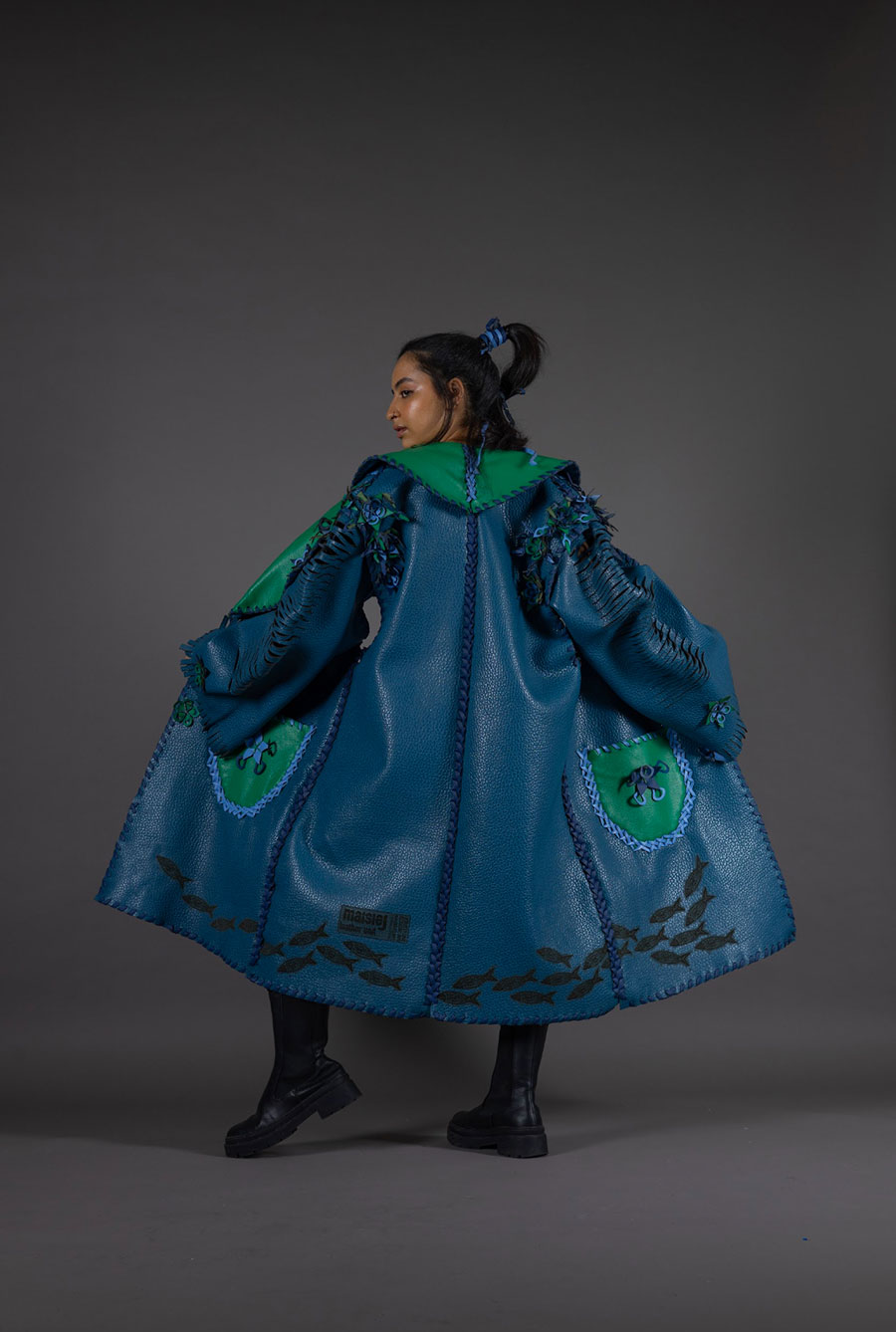Student Bursaries 2025
The Textile Society is sincerely grateful to Joy of Print for their generous contribution of £1,000 in support of the 2025 Student Bursaries scheme.
UNDERGRADUATE BURSARIES
Roisin Conway
Ulster University
£700
Rooted in Tradition: A Celebration of Heritage Through Print
Roisin’s interior print collection was inspired by her family heritage and the rural landscape of Armagh. Her parents run a small specialty farm, growing high-quality produce to reduce import dependency and carbon footprint, and their ethos of sustainability and locality is central to her work.
The judging panel found Roisin’s printed designs and execution of hand-printed and digitally printed techniques to be of the highest quality. Her nature-inspired motifs were truly beautifully drawn. Overall, a fantastic application, and we applaud her use of locally manufactured linens by Baird McNutt Weavers and her ambitions for ‘Studio Conway’.
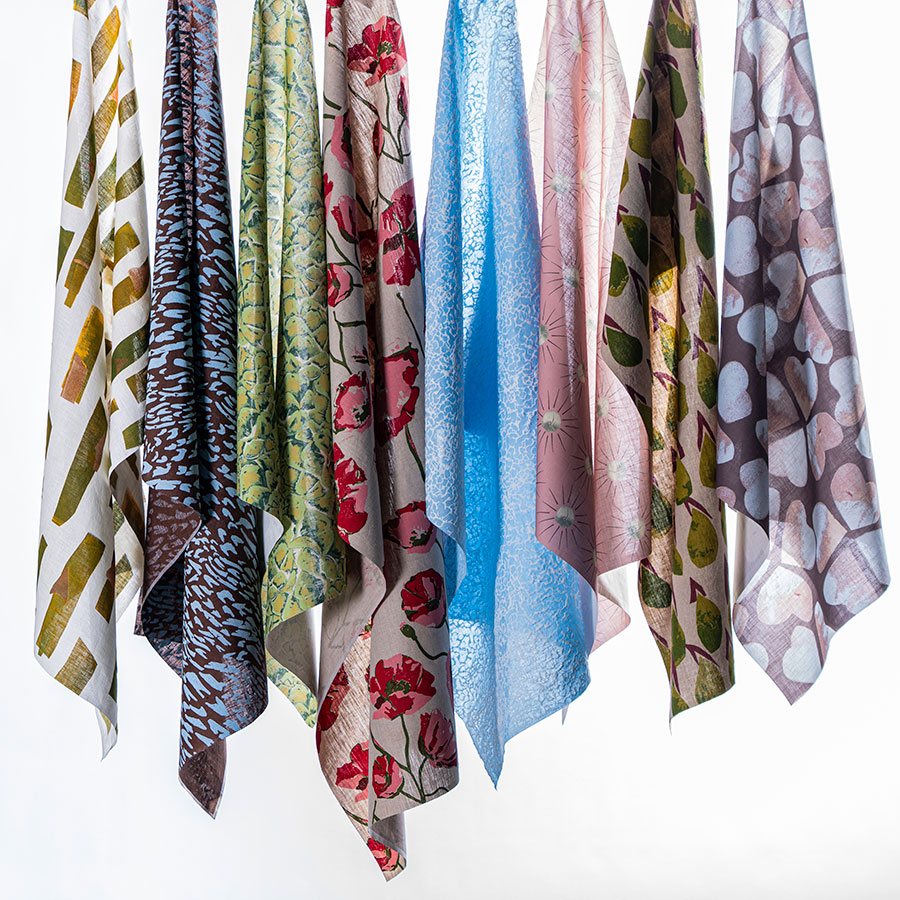
Karen Hamilton
Ulster University
£700
Light on Light
Karen’s woven collection ‘Light on Light’ is an exploration of light, colour and form in the natural world, and she presented a subtle and well-crafted series of samples and prototypes for wall hangings and installations. The judging panel were intrigued by Karen’s aim to translate light, not only artistically through colour and form, but also as an accurate scientific representation. Her collaboration with Dr Jonathan Kennedy, providing the authenticity she desired, and much food for thought for further development.
Karen’s proposal was well thought out, and ambitious in her use of the funding towards a proposed artist in residence programme at the Textile Centre, Haslach, clearly budgeted.
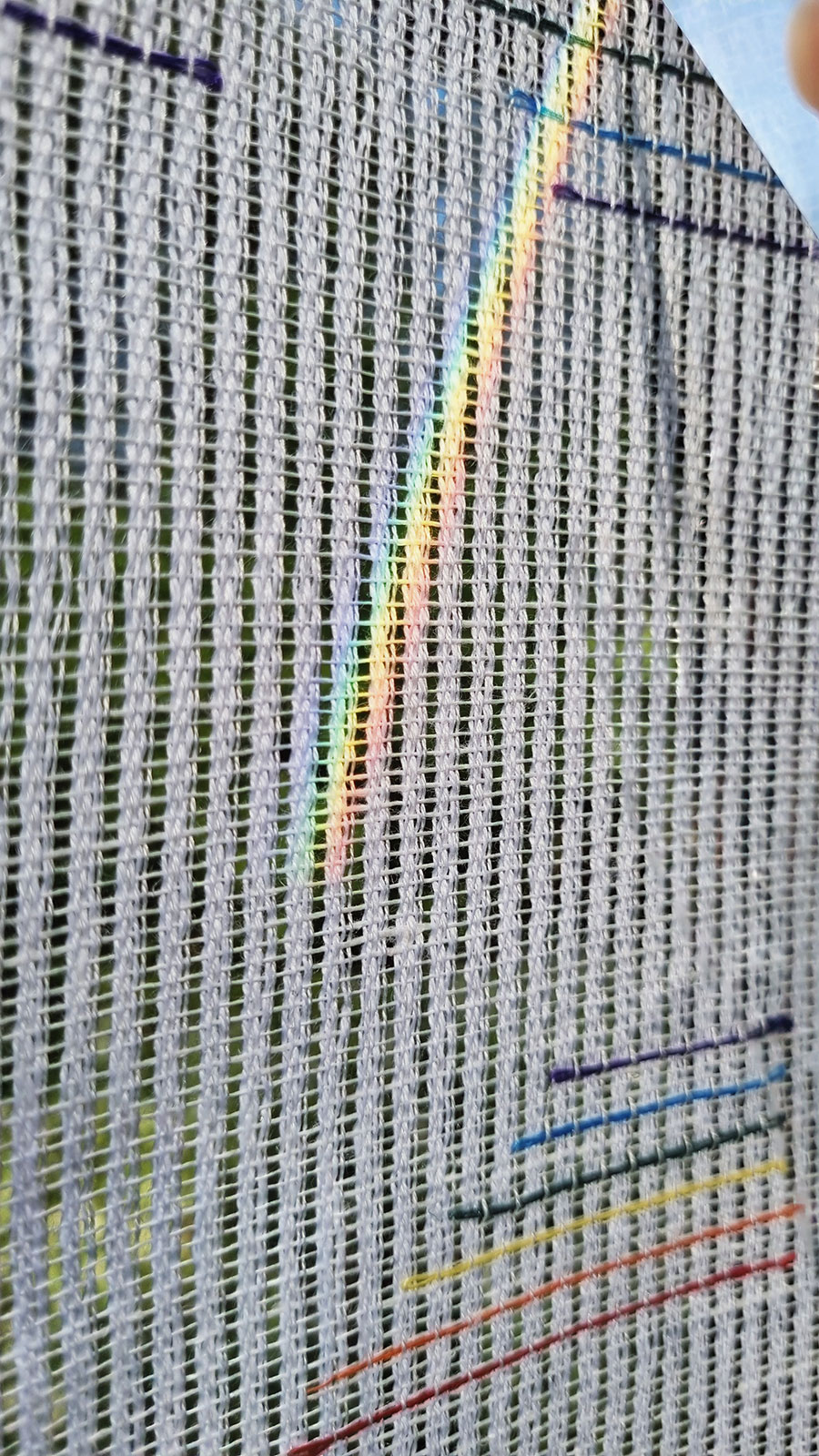
Leah Gasson
Loughborough University
£250
The Ephemeral Bride
Leah’s proposal featured fascinating experimental work with compostable materials. The project was seen to be an exciting beginning to the concept of organic grown ‘bridal lace’, using plant roots as a sustainable alternative to synthetic appliqued lace pieces.
The concept of designing a compostable garment, woven with seeds, to be buried after the wedding ceremony, and gradually grown into plants of the bride’s personal choice brought new life to the idea of disposable garments, with a great deal of thought and meaning. The judges found Leah’s work and aesthetic, inspired by traditional Japanese textiles, relevant and experimental, with much potential for the future to bring her ambitious ideas fully to fruition.
Leah’s application included a convincing, well-planned budget and written proposal.
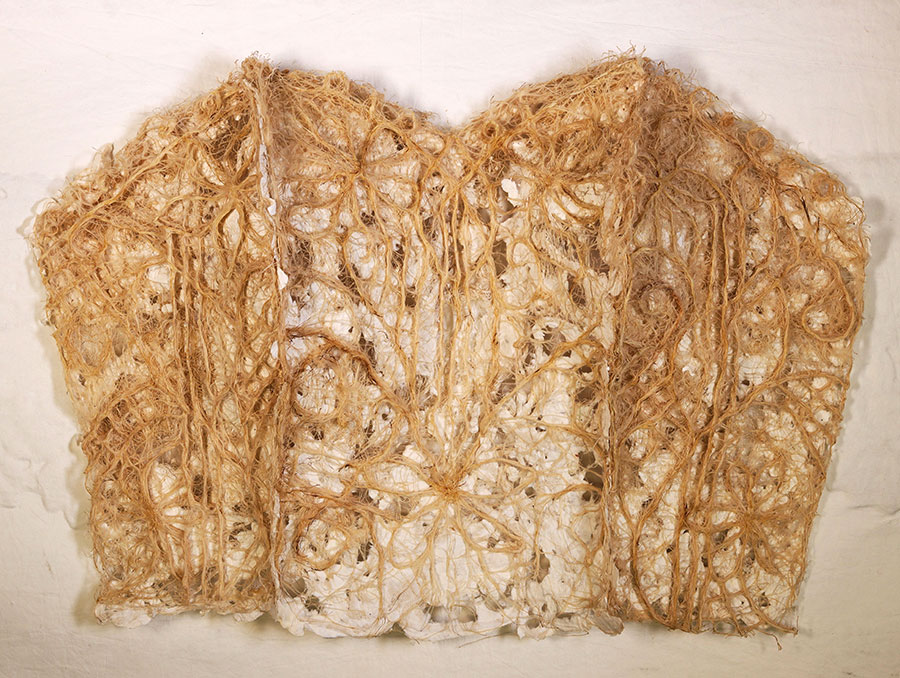
Poppy Porter
University of the Arts London, Central St Martins
£250
Tales of the Tide
Poppy’s project investigated how the tides deliver treasures to the shore. The judges loved how the initial inspiration for ‘Tales of the tide’ came from the time she found a message in a bottle with a dialogue evolving between her, her brother, the boy who wrote the message, learning about each other’s lives.
This great beginning developed into a sensitive and beautifully crafted contemporary interior collection, using both Dobby and Jacquard weaving techniques. We found Poppy’s commitment to sustainability admirable, including living and working on Fernhill Farm, a certified regenerative sheep farm producing soft, strong, and high-quality yarns, between September and December 2023.
This immersion in the process and culture of British sheep farming for wool, together with a very strong written application and justification via her budget plan and, of course, her physical sampling with great use of colour and pattern making, made Poppy a popular choice amongst the judges.
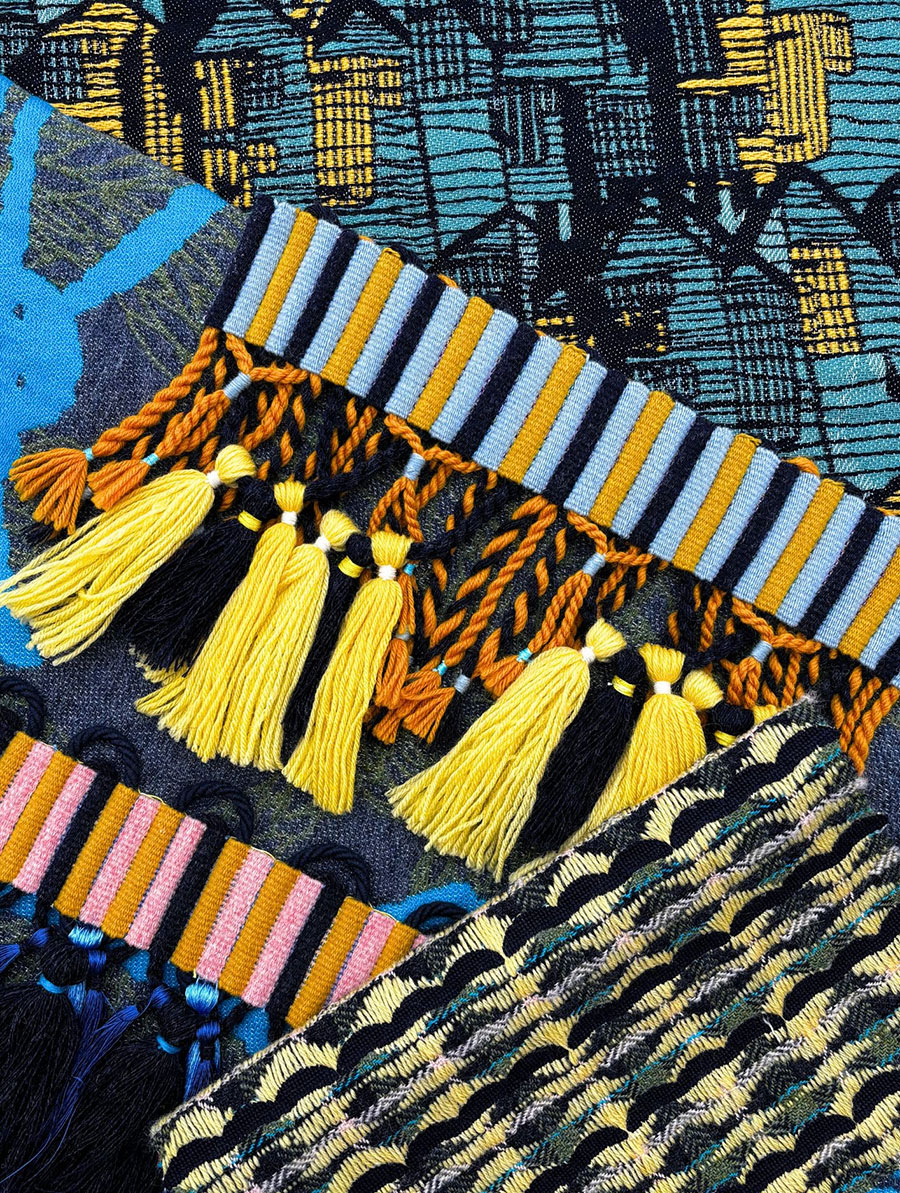
Oliver Roberts
University of the Arts London, Central St Martins
£250
Dave Goes Great Guns
Oliver’s proposal had a super personal link which the judges found delightful. His primary research began by recalling the sporting success of his late grandad, David Roberts. David was a boxing prodigy from Melton Mowbray and member of the Royal Army Ordnance Corps Boxing Team from 1961-1963. This wonderful heritage informed Oliver’s comprehensive research into the historical and modern contexts of knitted sportswear.
Oliver’s utilisation of innovative hand techniques, alongside Create+Stoll programming to devise fabrics suitable for sportswear, together with his chosen immersive colour palette, were eye-catching. We felt that Oliver’s work had a unique identity and loved his prototype cycling one pieces, joggers, jumpers, boxing gloves, and racket bag designs.
Overall, a very well written proposal and a budget plan that was straightforward but realistic, and relevant in terms of his ambitions for the future.
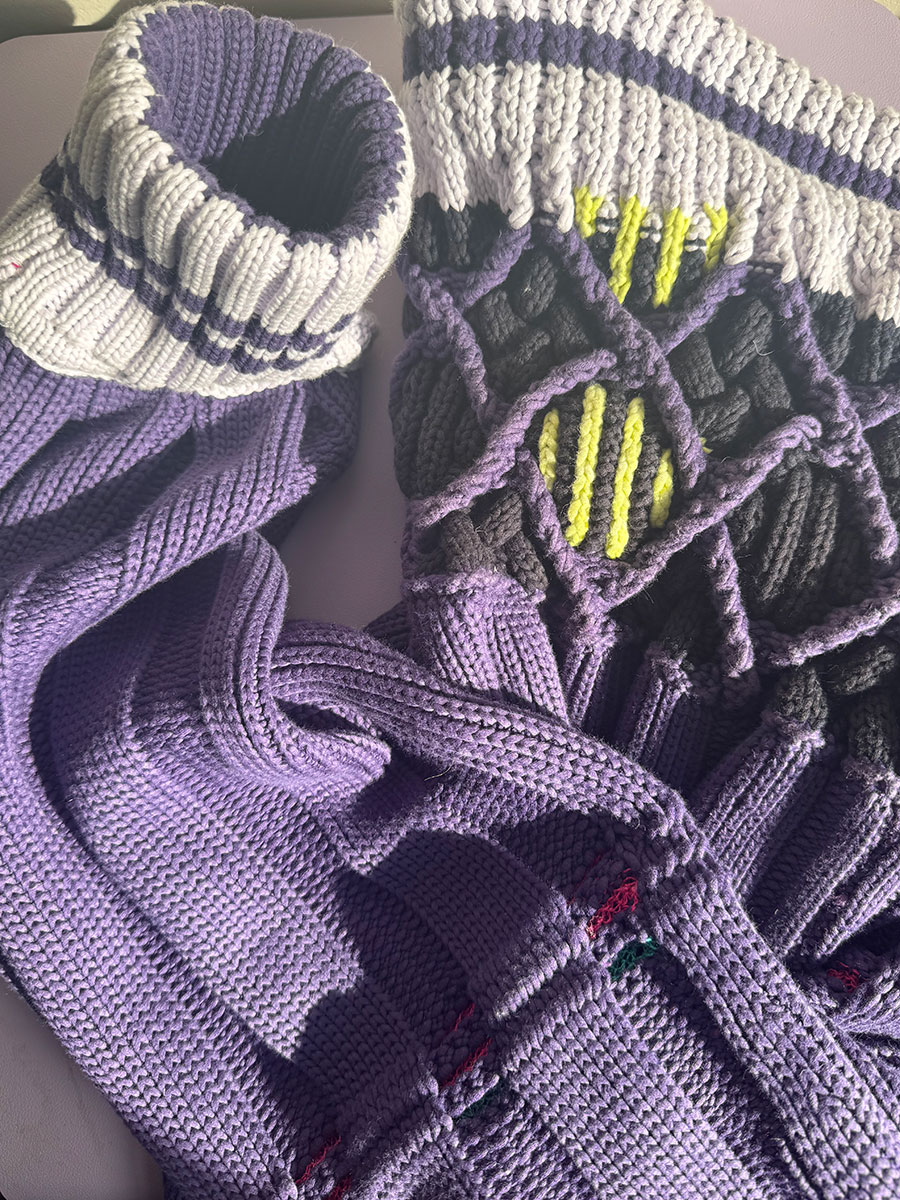
POSTGRADUATE BURSARIES
Caroline Mayers
Norwich University of the Arts
£350
Investigating Textile Materiality as a Means of Conveying Embodied Life Experience
Caroline’s textile art practice uses textiles as a medium to explore themes of memory, identity and emotional resonance towards the female body. Her project was deeply personal and intimate, exploring the stories held within fascia, a thin layer of webbed fibres, protecting human muscles which have been shown to hold memory of a body’s life experience. Caroline’s practice encompasses constructed textiles including weaving, knitting, crocheting, natural dyeing and stitching.
The judging panel thought Caroline’s work, for example, visibly and invisibly stitching marks and words to become metaphors for healing and repair, and dyeing to signify transformation with colour to layer memory and meaning into cloth, was very sensitive with much scope for development in the professional world.
Caroline’s contextual research and budget planning fully supported her application.
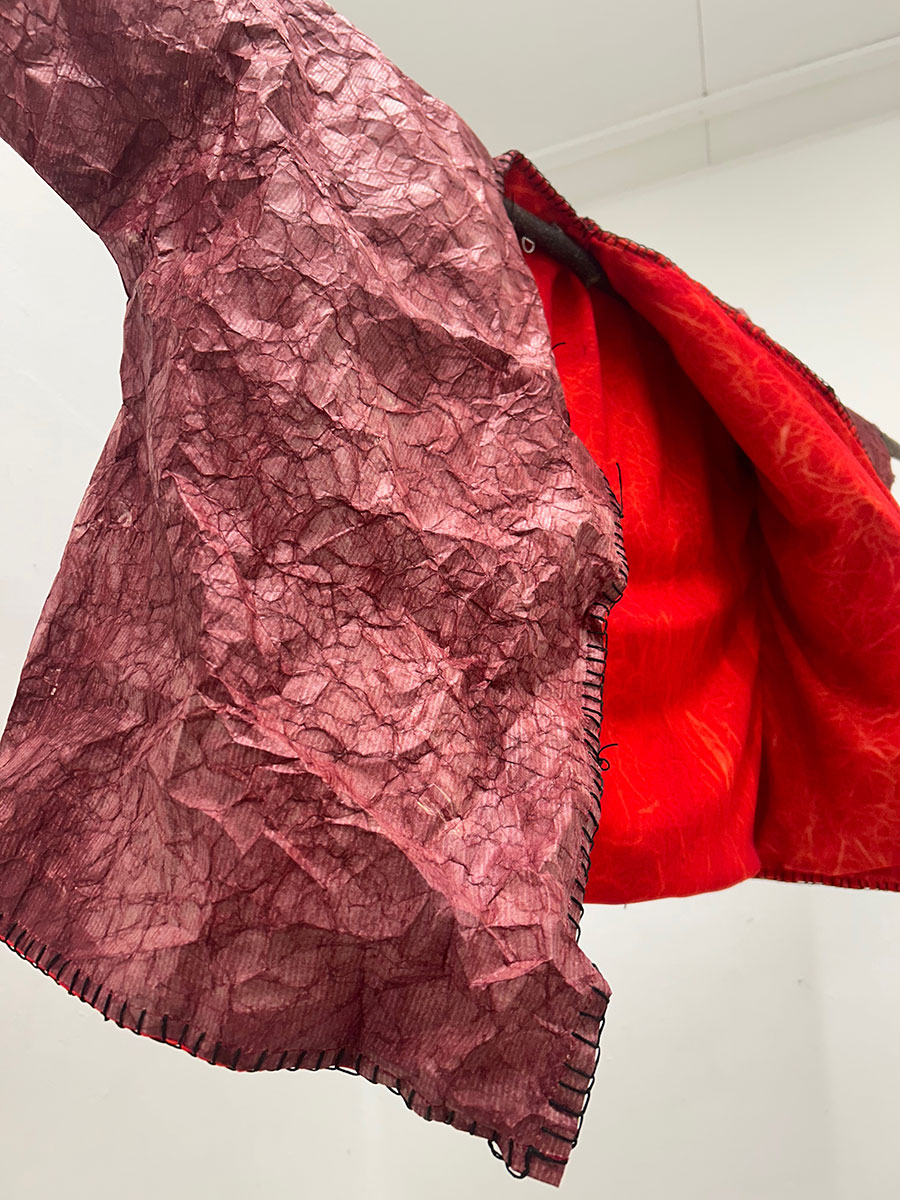
Mary Muir
Manchester Metropolitan University
£350
Stitch, Sea, Stone, Sky
For her MA in Fine Art final project, Mary produced a body of work inspired by the rich environment, culture and textile heritage of North Ronaldsay, the most northerly of 70 islands which form the Orkney archipelago, and one of only twenty of which are still inhabited.
Mary drew on all of the above, and North Ronaldsay wool, to create 2/3D pieces primarily using felted, hand spun rovings and batts to further investigate the many ways in which textile practice encourages us to think about place, temporality, memory, identity and mutability.
Overall, a beautifully written proposal, with excellent research and an exemplary case for support – one the judging panel could not ignore.
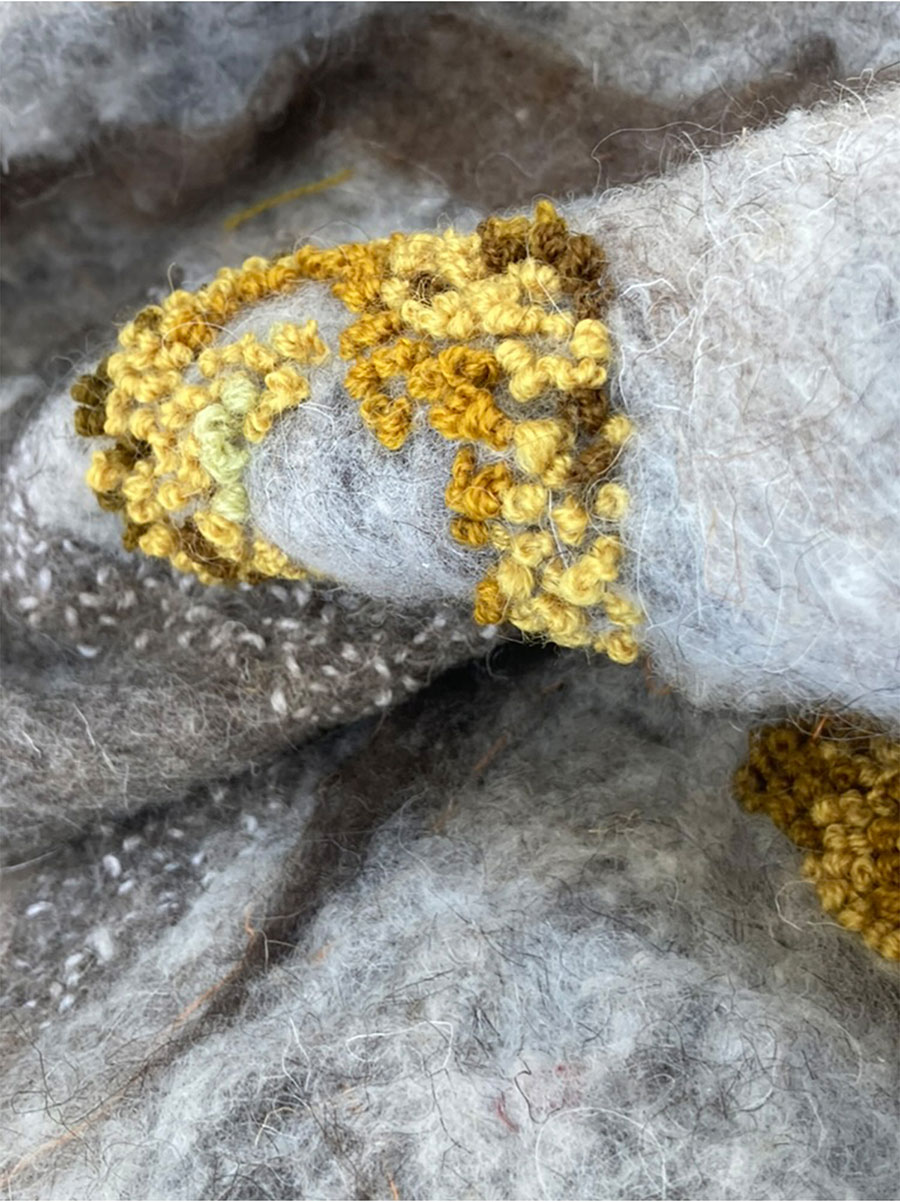
Jenna Handley
University of the Arts London, Central St Martins
£250
Seafibre
Jenna’s project explores Cornish seaweed’s potential as a material alternative to support both the heritage and future of textiles.
As Cornwall is Jenna’s home and has its own heritage and unique community, her project aimed to support this and local biodiversity from the roots up, highlighting local resources and skills. Her work centred around the production of a collaborative jumper, a gansey, featuring several knitters, their initials and local traditional patterns. The project gave a voice to the historically silenced ‘women’s work’, and to her research into transparency within contemporary material supply chains.
The judging panel admired Jenna’s aim to draw on the timelessness of a gansey whilst exploring modern knitwear, to engage younger audiences with their heritage and environments. Overall, her project was well supported by a detailed budget plan and coherent achievable timeline.
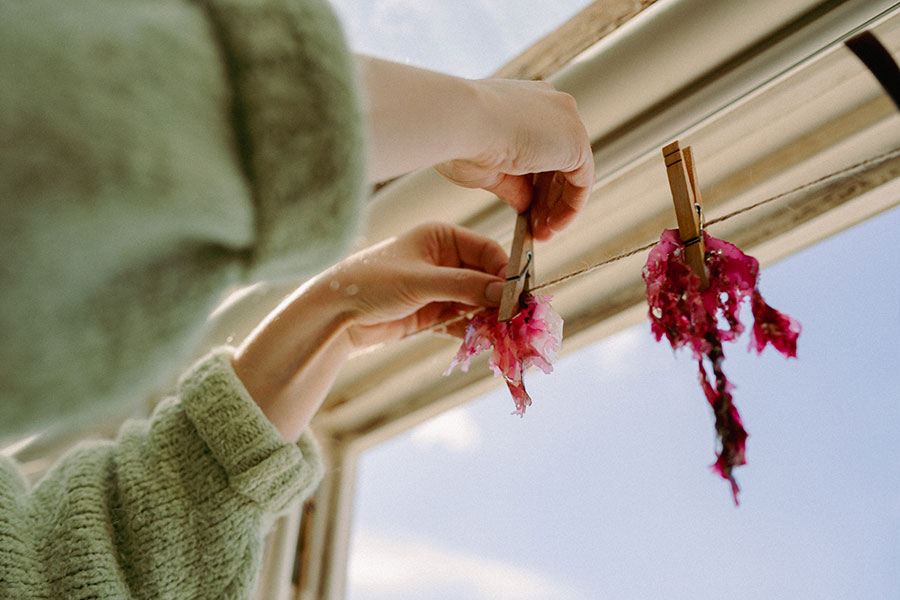
Eileen Morley
Royal College of Art
£250
Learning to Guernsey
Eileen’s project was based on the history of, and process of researching, the materials and textures of knitting. From this research she was incredibly drawn to Guernsey, an island renowned for its wool sweaters. Intriguingly, in her practice Eileen uses the language of knitting and stitching to shape found objects into small sculptures. Serendipitous encounters while cycling bring her things like broken bike locks, lightbulbs, and rocks, and fibres ‘find their way to me’ through older hands, scrap shops, and even repurposing past projects.
Eileen’s work aims to hold on to objects that evidence our existence but have been discarded or deemed not inherently useful. Overall, her plan to travel to Guernsey and work with the brand Le Tricoteur to learn how to make a Guernsey with knitters from the island, and bring together the discarded with the highly crafted and wearable, was seen to be exciting and valid by the judging panel.
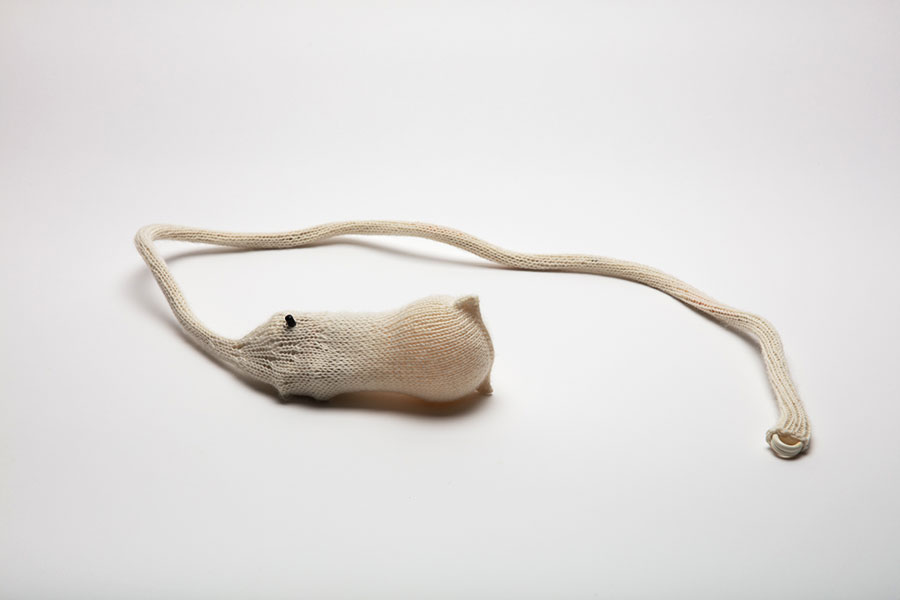
Well done to all those additional undergraduates and postgraduates who received commendations from the panel of judges.
ANNE MORRELL PRIZE
We are delighted to announce two additional undergraduate awards supported by Anne Morrell, Professor of Textiles and former Head of Embroidery at Manchester Metropolitan University
Amber Fry
University of the Arts London, Central St Martins
£700
Plot 24
We were truly blown away by Amber’s commitment to her work and her allotment. Her collection ‘Plot 24’ combined ancient dyeing/fibre knowledge and craft skills with modern design aesthetics to produce a playful collection of bespoke woven fabrics for high end interior homewares, in particular bespoke handwoven blankets and throws.
Amber’s aim to only use natural fibres produced within the locality of her own allotment in Kent, to create decentralised textile supply chains with reduced transport miles, should be celebrated, as should her ambition to work with Romney Marsh wool dyed entirely with her home-grown plants. This resourceful approach together with well-articulated costings impressed the judging panel and, of course, the beauty and craftsmanship of her very contemporary textile collection.
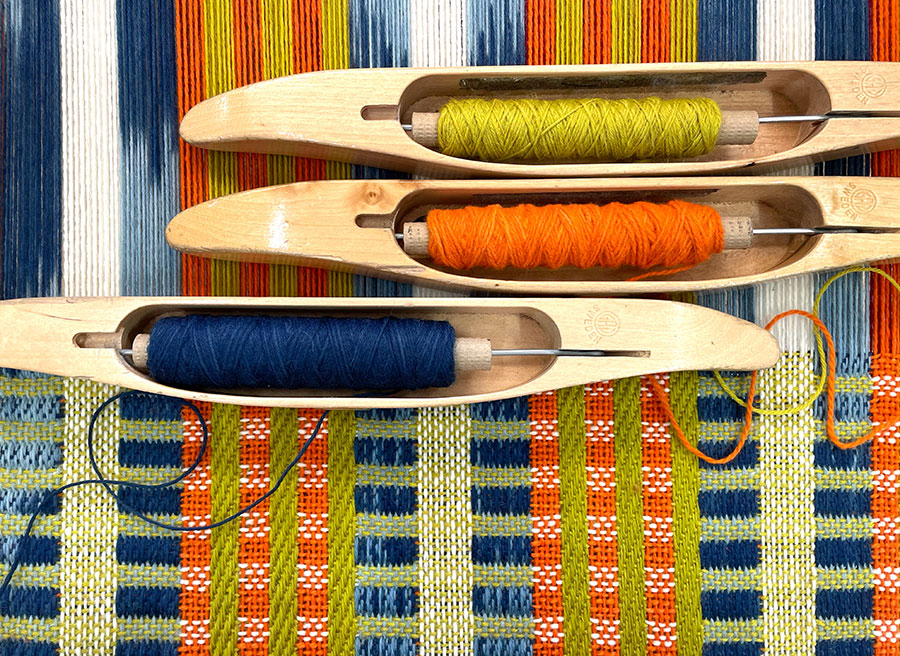
Maisie Ingram
University of Portsmouth
£700
Reengineering Leather: A Mono-Material Approach to No-Sew Sustainable Innovation’
Maisie’s collection offered exciting developments in the field of laser cut leather for fashion.
The judging panel loved the way in which Maisie merged technology with artisanal craftsmanship, beginning with hand-cut lino prints – an inherently tactile and personal process – before digitising and rastering them onto leather. How she engineered three-dimensional textiles through interlocking cut systems slotted together, without adhesives or stitching, was very exciting, and expanded construction possibilities in a decorative manner. Maisie’s mono-material approach extended to prototype garment assembly, eliminating stitching in favour of leather weaving techniques. Her aim to develop a ‘no-sew’ method, ensuring easy disassembly and recyclability at the garment’s end of life was admirable.
Maisie’s overall proposal and budget planning was very well articulated and argued.
